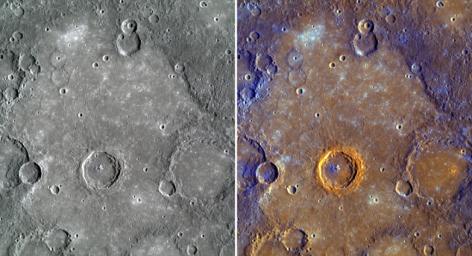Rudaki Plains in Color
Caption:
Last week, MESSENGER team members presented the results from four papers published in the 1 May issue of
Science
magazine at a NASA media teleconference. The color views shown here of the plains near
Rudaki crater
was just one of the graphics presented at that teleconference. The left image was created by combining WAC images from three narrow-band color filters to approximate Mercury's color as it would be seen by the human eye. The right image used a statistical analysis of all 11 WAC filters to highlight subtle color differences on the surface, as has been used for many previous releases, such as ones focused on
Thākur crater
and
Caloris basin
.
Click here
to read more about this graphic and see others presented at the NASA media teleconference.
Date Acquired:
October 6, 2008
Image Mission Elapsed Time (MET):
131770571-131770621
Instrument:
Wide Angle Camera (WAC) of the Mercury Dual Imaging System (MDIS).
WAC Filters:
Left image: 3, 4, 5 (480, 560, 630 nanometers). Right Image: statistical analysis involving all 11 WAC filters
Scale:
The crater in the center of the image is 68 kilometers (42 miles) in diameter
Spacecraft Altitude:
2,800 kilometers (1,700 miles)
Background Info:
These images are from MESSENGER, a NASA Discovery mission to conduct the first orbital study of the innermost planet, Mercury. For information regarding the use of images, see the MESSENGER
image use policy
.
Cataloging Keywords:
| Name |
Value |
Additional Values |
| Target |
Mercury |
|
| System |
|
|
| Target Type |
Planet |
|
| Mission |
MESSENGER |
|
| Instrument Host |
MESSENGER |
|
| Host Type |
Orbiter |
|
| Instrument |
Mercury Dual Imaging System (MDIS) |
|
| Detector |
Wide Angle Camera (WAC) |
|
| Extra Keywords |
Color, Crater |
| Acquisition Date |
|
| Release Date |
2009-05-05 |
| Date in Caption |
2008-10-06 |
|
| Image Credit |
NASA/Johns Hopkins University Applied Physics Laboratory/Smithsonian Institution/Carnegie Institution of Washington |
| Source |
photojournal.jpl.nasa.gov/catalog/PIA12050 |
| Identifier |
PIA12050 |

 Planetary Data System
Planetary Data System
